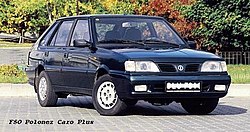FSO Polonez
| FSO Polonez | |
|---|---|
 | |
| Overview | |
| Manufacturer | FSO |
| Also called | FSO Caro |
| Production | 1978-2002 |
| Body and chassis | |
| Class | Small family car |
| Body style | 4-door Sedan 5-door Kombi 2-door Pick-up |
| Related | Fiat 1300/1500 Fiat 125 |
| Chronology | |
| Predecessor | Polski Fiat 125p |

The FSO Polonez is a Polish motor vehicle produced from 1978 to 2002.
Essentially the car was a rebodied Polski Fiat 125p, which FSO built under licence from Fiat, based on the Fiat 125. The internal components (engine, chassis, and other mechanicals) were straight from the Polski Fiat 125p, but clothed in a "modernised" hatchback body.
The car name comes from the Polish dance, polonaise.



Over the years, the Polonez range was expanded to encompass a wide range of bodies. These included:
- Hatchback (as originally introduced)
- Saloon
- Estate (sold in some markets as the FSO Caro)
- Pick-up
- Extended Pick-up
- Special-bodied service vehicle
- Special edition for Polish Fire Brigade
- Ambulance
During the mid-1990s a Citroën 1.9 diesel engine was introduced to the range, and in various forms, the car was sold across mainland Europe. Various cosmetic changes were made on more than one occasion.
In the late 1980s a batch of 150 Polenez hatchbacks was exported to New Zealand (their reliability were considered worst than Ladas). They were also exported to Chile from the late 1980s to early 1990s. In some countries the FSO Polonez was sold as FSO Celina.
The FSO Polonez suffered from poor performance, especially compared with newer vehicles during the latter part of its production run. Reliability was also patchy but this was somewhat offset by the fact that Polonez parts were relatively cheap and readily available. The last production models offered new features such as electric windows, but these too were very unreliable.[citation needed]
Production eventually ended, 24 years after it had begun, due to the fact the potential buyers preferred to buy used cars imported from western Europe to the Polonez which, being an old design was unable to meet ever-stricter European regulations. Demand slumped and the last versions of the Polonez produced were Polonez Cargo versions valued for their low price. The Polonez is a common sight in Central and Eastern Europe, particularly in its home country, Poland, but after Poland joined the European Union in May 2004 is quickly replaced by cheap, tax free, much more modern used cars from the western European countries.
